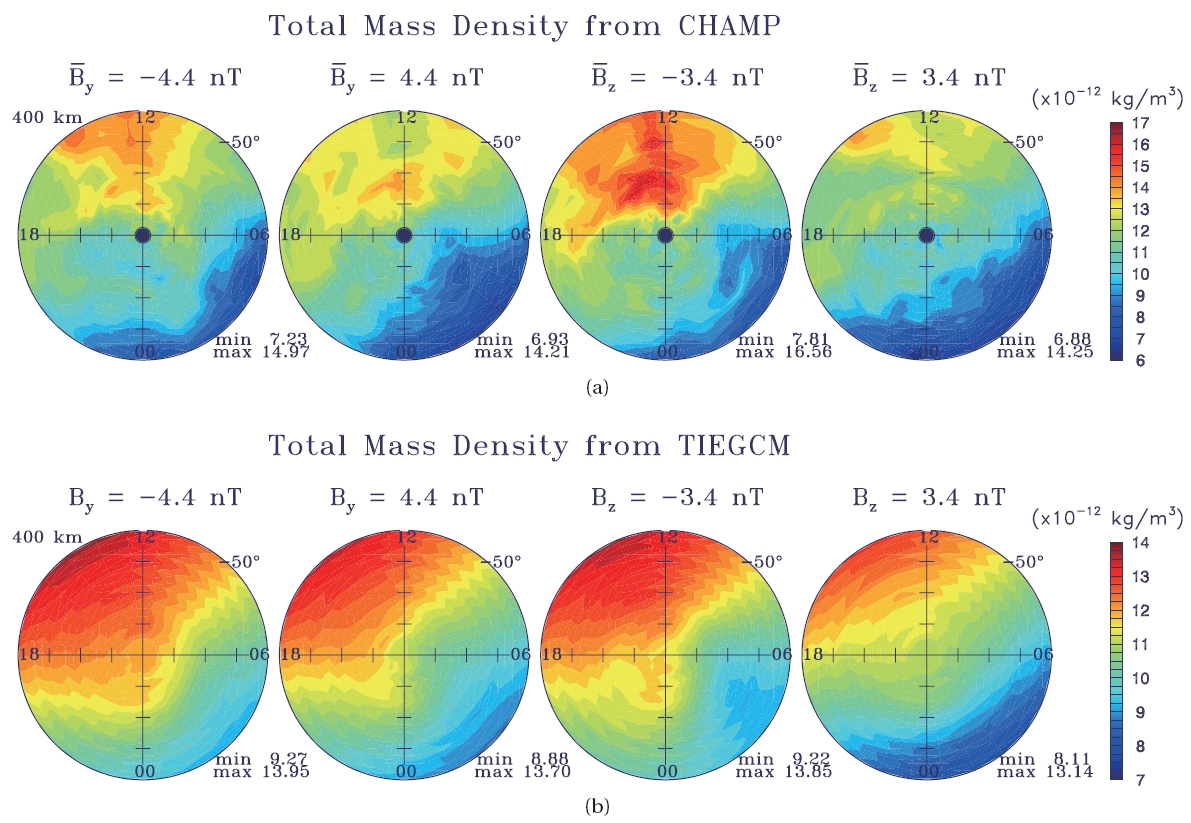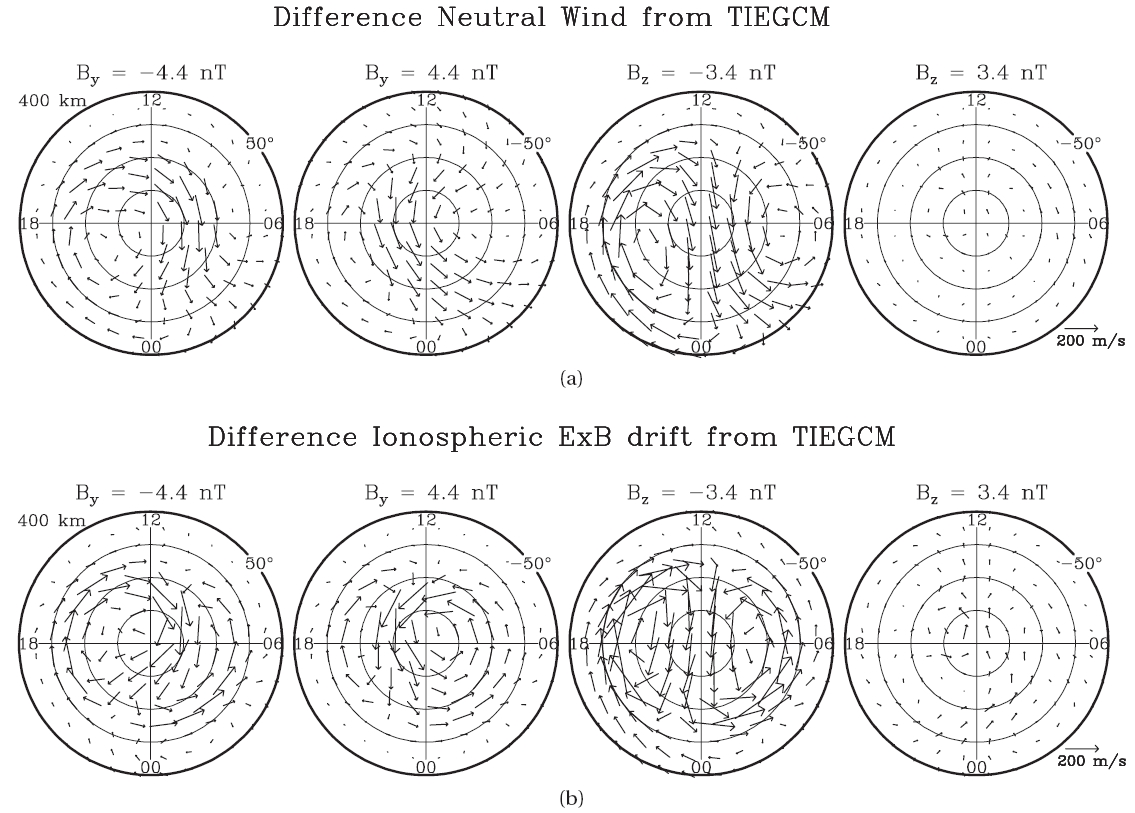



Thermospheric neutral mass density, which primarily determines the atmospheric drag, is an important parameter for satellite operations in the near-Earth space, and is also very useful for understanding the thermosphereionosphere coupling process as well. The thermospheric neutral mass density is highly variable in space and time by various energy and momentum sources. In particular at high latitudes, these sources are directly or indirectly associated with the direction and/or strength of the interplanetary magnetic field (IMF) (McCormac & Smith 1984, McCormac et al. 1985, 1991, Killeen et al. 1985,1995, Meriwether & Shih 1987, Thayer et al. 1987, Rees &Fuller-Rowell 1989, 1990, Sica et al. 1989, Hernandez et al.1991, Niciejewski et al. 1992, 1994, Won 1994, Richmond et al. 2003, McHarg et al. 2005, Zhang et al. 2005, Kwak & Richmond 2007, Kwak et al. 2007, Luhr et al. 2007, Forster et al. 2008). Therefore, there is an intimate relationship between the IMF variation and thermospheric density variation (Crowley et al. 2006, Rentz & Luhr 2008, Kwak et al. 2009).
Recently, Kwak et al. (2009) have carried out the systematic analysis of observed IMF
Further study is necessary to identify why the variation of the thermospheric neutral mass density is dependent on the orientation of the IMF. In this paper, we extend the work of Kwak et al. (2009) by conducting model simulations by using the coupled model of the National Center for Atmospheric Research Thermosphere-Ionosphere Electrodynamics General Circulation Model (NCAR-TIEGCM) and a new empirical model that provides a forcing of the thermosphere in high latitudes.
The TIEGCM (Richmond et al. 1992) used in this study is an extension of the NCAR-TIGCM (Roble et al. 1988) that incorporates the electrodynamic processes. The TIEGCM simulates self-consistently the neutral winds, conductivities, electric fields and currents. The model calculates the neutral gas temperature and mass mixing ratios of
The model simulations are conducted by using the seasonal and solar conditions on January 5, 2002. The F10.7 index was 224 × 10-22 W/m2/Hz and the total hemispheric power (HP) was 16 GW on that day. The HP is related with Kp index by HP (GW) = -2.78 + 9.33 × Kp (Maeda et al. 1989). The mean Kp index on January 5, 2002 was 2. The prescriptions of the upward propagating diurnal and semidiurnal tides are taken from the Global Scale Wave Model (GSWM) (Hagan & Forbes 2002). The TIEGCM used in this study is coupled with a new empirical model of the high-latitude forcing on the thermosphere including electric field, magnetic potential and Poynting flux, and soft particle precipitation to the polar region (Deng et al. 2008) is considered.
To investigate the response of the thermospheric density to varying IMF, we made five TIEGCM simulations for IMF (
Quantities considered to investigate the potential source of the variation of the neutral mass density in the high latitudes are E × B drifts, neutral winds, and heating terms including auroral heating and joule heating. We first bin each quantity at 400 km altitude for each universal time in magnetic coordinates for different orientations of the IMF; we analyze the quantities in Quasi-Dipole (QD) coordinates (QD-latitude and magnetic local time [MLT]) (Richmond 1995). Especially, for analysis of E × B drifts and neutral winds, the QD-latitude/MLT region poleward of 47.5°S is divided into 145 subregions of approximately equal size, each having 5° width in latitude, and a variable, latitude-dependent, width in MLT. The number of MLT subregions at a given latitude decreases from 32 at 50°S to 4 at 85°S, plus one at the pole.
We then carry out an averaging for 24 UT hours of each quantity in each bin for each of the different IMF conditions. The resultant values can be then mapped out over magnetic latitude and MLT.
4.1 Comparison between thermospheric neutral mass densities from model and observations
To examine how well the thermospheric densities from the TIEGCM agree with the observations, we compare the results of the TIEGCM with densities derived from
the high-accuracy accelerometer on board the CHAMP spacecraft as analyzed by Kwak et al. (2009).
Figs. 1a and b show the average thermospheric neutral mass densities at 400 km over the southern summer hemisphere in the poleward latitude -50° for IMF (
The general agreement between thermospheric density observations and model results indicates that we can use the model to analyze in more detail the sources that drive the neutral density variations in the summertime high-latitude thermosphere.
4.2 Effect of the IMF on the thermospheric neutral mass density variations
Fig. 2 shows the difference of thermospheric neutral mass densities (subtraction of the values for zero IMF condition from the values for non-zero IMF conditions) at 400 km over southern-hemisphere high latitudes for the four IMF (
values are relatively larger than those in the dawn sector. The positive-
4.3 Driving sources for the high-latitude thermospheric density variations
A possible interpretation for different thermospheric density patterns for different IMF conditions is that the high-latitude thermospheric density is strongly determined by thermospheric winds, which are associated with the ionospheric convection and vary strongly with respect to the direction of the IMF. Geostrophic adjust theory, as it applies to the thermosphere (Larsen & Mikkelsen 1983, Walterscheid & Boucher 1984), indicates that winds and horizontal pressure gradients tend to be linked, such that a cyclonic wind vortex tends to have a low pressure and density at its center, while an anti-cyclonic vortex tends to have a high pressure and density at its center.
Fig. 3 shows the difference of neutral winds and difference ionospheric convection velocities at 400 km over southern hemisphere high latitudes for four IMF (
through the ion drag. The difference winds for negative B y show a strong high-latitude anticyclonic vortex on the dusk side. The difference winds for positive
If the geostrophic adjust theory is applied to the thermosphere, we would expect strong anticyclonic winds on the dusk side for negative-
Additionally, thermospheric density variations can be also influenced by the local heating including joule heating and auroral heating associated with ionospheric currents and/or auroral particle precipitation, which vary with IMF conditions. Indeed, the heating may generate upward neutral motion and cause an increase of total mass density.
Fig. 4 shows difference heating terms at 400 km altitude over the southern hemisphere for IMF (
If these difference heating distributions are considered with the thermsopheric density distributions from Fig. 2, we can see the high-latitude thermospheric density variations in auroral and cusp regions, especially near cusp region for negative
In this paper, we present the investigations of the driving sources for the high-latitude thermospheric density variations depending on the IMF conditions. For this study, we analyzed steady state condition for different IMF directions, for summer conditions in the southern hemisphere, on the basis of numerical experiments with the NCAR-TIEGCM coupled with a new quantitative empirical model of the high-latitude forcing on the thermosphere.
The difference high-latitude thermospheric densities, obtained by subtracting values with zero IMF from those with non-zero IMF, vary with IMF conditions: There are significantly enhanced difference densities in the dusk sector and around midnight when
A possible interpretation for different thermospheric density patterns for different IMF conditions is that the high-latitude thermospheric density, especially in the dawn and dusk sectors, can be strongly determined by thermospheric winds, which are associated with the ionospheric convection and vary strongly with respect to the direction of the IMF: Strong anticyclonic winds on the dusk side for



